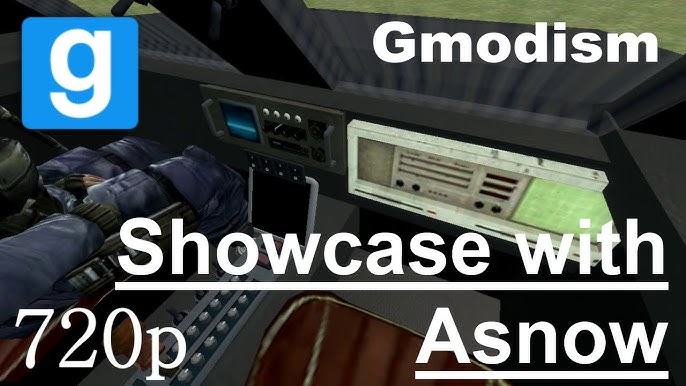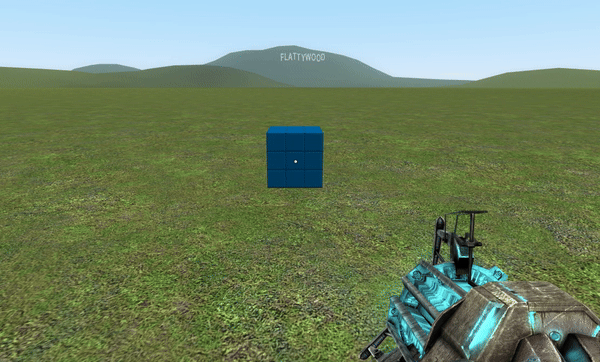Unleashing Creativity: How Lua Scripting Made Garry's Mod a Sandbox Phenomenon Back in 2010, fueled by late-night energy drinks and a burning desire to create something unique, I dove headfirst into the world of Garry's Mod.

Back in 2010, fueled by late-night energy drinks and a burning desire to create something unique, I dove headfirst into the world of Garry's Mod. The appeal was undeniable: a blank canvas, the raw potential to build anything imaginable, and the enticing promise of Lua scripting to bring it all to life. I started ElysiumRP, a roleplaying server, and quickly learned that the road to custom content was paved with frustrating debugging sessions and late-night coding binges. I still remember the sheer elation of creating my first functional script: a simple door system that used a networked variable to track its open/close state using ULib. Resources were scarce back then – sparse online documentation, trial-and-error experimentation, and the collaborative spirit of the Garry's Mod community was all we had. And then there was the constant paranoia of your best scripts getting "leaked" and ending up on Scriptfodder. But it was all worth it. Lua scripting was the engine that powered GMod's endless creativity.
The Power of Lua in GMod: Scripting the Sandbox
Lua scripting within the Source engine was the magic wand that transformed Garry's Mod from a physics playground into a universe of player-created content. It unlocked the ability to reshape the game in ways the developers probably never imagined.
Entity Manipulation: Building Worlds One Prop at a Time
Lua gave us the power to manipulate in-game entities – props, NPCs, weapons – and even create entirely new ones from scratch. Functions like ents.Create and entity:SetModel were the bedrock of countless player creations. Suddenly, you could spawn a simple "Combine Turret" entity and then rewrite its behaviors to act as a sentry gun for your base or a friendly companion. We saw custom vehicles emerge, like meticulously recreated versions of the Delorean from "Back to the Future" or the Batmobile, meticulously crafted from basic shapes and fine-tuned using SetVelocity and ApplyForce.
Interactive environmental puzzles became a reality. I remember setting up a series of laser tripwires that, when triggered, activated turrets and locked down a room using custom doors controlled by networked variables. Dynamic AI behaviors were also possible. We built custom NPC shopkeepers with complex dialog trees, delivering information and services to players using net messages to syncronize the display text across clients. The possibilities were truly limitless.
Hook System: Rewriting the Rules
The hook system was another cornerstone of GMod's scripting power. It allowed scripts to intercept and modify existing game events, essentially rewriting the game's rules on the fly. Want to disable fall damage? Hook into GM:PlayerFall and negate the damage calculation. Need an anti-cheat system? Track player position history within GM:Think to detect teleportation exploits.
GM:PlayerSpawn was a particularly useful hook, allowing us to immediately equip new players with a starter weapon and set their initial spawn location, adding context-sensitive functionality. GM:Think could constantly update a player's health or check for specific conditions, triggering events or applying status effects. HUDPaint allowed for creating custom user interface elements, displaying objectives, health bars, or even completely replacing the default HUD. It was this level of control that allowed us to craft custom game experiences unlike anything else.
Networking: Making It Multiplayer
Multiplayer gameplay was at the heart of Garry's Mod, and Lua's networking capabilities made it possible. Networked variables were crucial for synchronizing data between clients and the server, ensuring everyone saw the same game state.
However, it wasn't always smooth sailing. Synchronizing data efficiently was a constant challenge. We had to be mindful of bandwidth limitations and optimize our scripts to minimize network traffic. One trick was to use util.Compress to reduce the size of data packets before sending them, especially when dealing with large tables or strings. net.WriteTable and net.ReadTable became staples for transmitting complex data structures, but we constantly battled with overflowing the maximum packet size, leading to dropped connections and frustrating debugging sessions.
Metatables: Extending the Language
Metatables were an advanced concept, but they offered even greater flexibility. They allowed us to extend the functionality of existing Lua types, creating custom data structures and overriding default behaviors. For example, you could use metatables to add custom abilities to players, storing them within a custom table accessible from the entity, or define how two custom entities interact through metatable overrides. It was a powerful tool for those willing to dive deep into Lua's intricacies.
Constraints and Creative Solutions: Innovation Under Pressure
The limitations of Lua scripting within the Source engine – performance bottlenecks, limited memory, the lack of robust debugging tools - weren't roadblocks; they were catalysts for creative problem-solving.
Optimization: Squeezing Every Last Frame
Performance was always a concern. A poorly optimized script could bring an entire server to its knees. We became experts in code profiling, using the in-game timer library to identify performance bottlenecks. Minimizing garbage collection by reusing variables and avoiding unnecessary calculations through caching became second nature. Commands like DebugOverlay() became our best friends, allowing us to visualize performance data and pinpoint slow areas. Displaying the framerate of a specific piece of code or measuring the time it took to execute a function call were invaluable techniques.
Security: Guarding Against Exploits
Running player-created Lua scripts on a server opened up a Pandora's Box of security risks. Code sandboxing using RunString, input validation, and anti-exploit measures became essential. We spent countless hours scrutinizing code for potential vulnerabilities, such as remote code execution (RCE) attacks that could be triggered through malicious include statements with harmful URLs. Rigorous code reviews and limiting function calls were vital in preventing these exploits.

Resource Management: Avoiding the Memory Leak Monster
Managing memory and preventing memory leaks was another constant battle. Forgetting to properly clean up entities and data structures could lead to performance degradation and, eventually, server crashes. SafeRemoveEntity became a mantra, and setting variables to nil after they were no longer needed became a habit. We dreaded the insidious issues caused by unparented entities that persisted across map changes, slowly consuming memory and degrading performance.
Specific Examples of Innovative Gamemodes: From Roleplay to Mayhem
Lua scripting enabled a diverse ecosystem of innovative gamemodes, each offering a unique gameplay experience.
DarkRP: The City Simulator
DarkRP stands out as a prime example of how Lua scripting transformed GMod into a persistent and engaging roleplaying experience. The Lua scripts controlled almost every aspect of the game: jobs (police officers arresting citizens), laws (speeding regulations, weapon restrictions), and economic systems (player-owned businesses with custom interfaces). We leveraged Lua to create weapon skins, player models, and even entire vehicle sets. The emergent gameplay that arose from these systems, the dynamic interactions between players, and the feeling of inhabiting a living, breathing city were truly remarkable.

Trouble in Terrorist Town (TTT): Deception and Deduction
Trouble in Terrorist Town (TTT) demonstrated how Lua could create compelling social deduction games. The scripts handled player roles (Innocent, Detective, Traitor), weapon assignments (the Traitor's hidden weapons), and voting mechanics. We used a net stream to track votes during the identification phases, creating a sense of tension and suspense. Random events, map-specific features, and the ever-shifting dynamics between players made each round a unique experience.

Jailbreak: Order vs. Chaos
Jailbreak combined competitive gameplay with roleplaying elements in a unique and chaotic way. Lua scripts controlled the prison environment (locking and unlocking cell doors), the guard duties (giving orders and managing prisoners), and the prisoner rebellions (allowing prisoners to acquire weapons and escape). The dynamic interplay between guards and prisoners, the unexpected twists and turns, and the constant threat of rebellion made Jailbreak a truly unforgettable experience.
Advanced Physics-Based Contraptions: Engineering Marvels
Lua made it possible to create incredibly complex physics-based contraptions. Elaborate vehicle systems, intricate Rube Goldberg machines, and other physics-defying creations became a testament to the ingenuity of the GMod community. The scripts controlled physics interactions, animations, and user interfaces. Functions like SetVelocity and ApplyForce allowed for precise control over movement, while Sequence manipulations enabled complex animations. Custom user interfaces, such as speedometer displays built from projected textures, added another layer of polish.

Community and Legacy: Shaping the Future of Gaming
The GMod scripting community fostered a culture of sharing and collaboration, leaving a lasting impact on game development.
Sharing and Collaboration: The Power of Collective Knowledge
The GMod scripting community thrived on sharing and collaboration. Platforms like the Facepunch forums, the Garry's Mod Wiki, and code repositories such as GitHub facilitated knowledge exchange. Experienced scripters generously shared their expertise, guiding newcomers and fostering a supportive environment. Of course, we also had the "script kiddie" phenomenon, and we all did our best to point them in the right direction.
Influence on Modern Games: Player Agency Takes Center Stage
The lessons learned from GMod scripting have profoundly influenced modern game development. Games with robust modding support, like Minecraft, and procedural content generation systems, like No Man's Sky, owe a debt to GMod's legacy. The concept of player agency, fostered by GMod, is now a common feature in many modern games, empowering players to shape their own experiences.

The Future of Sandbox Gaming: AI-Powered Creativity
The future of sandbox gaming is bright, with scripting playing an even more significant role in empowering player creativity. AI-assisted scripting tools using Large Language Models hold immense potential, automating tedious tasks and making scripting more accessible to a wider audience. Metaverse platforms like Roblox are already pushing the boundaries of player-created content, but they also present technical and ethical challenges that we must address responsibly.
As someone who now works on networked physics and emergent systems, I can confidently say that my time scripting in Garry's Mod was invaluable. It taught me the fundamentals of game development, the importance of community, and the power of Lua scripting to transform a simple sandbox into a universe of endless possibilities.
Garry's Mod showed the world what could happen if you gave players the tools to build their own experiences, and it helped launch the careers of so many developers. I hope it keeps inspiring and challenging us for years to come. What will you build?
Editor's note: If you're ready to dive into Lua scripting, check out XenGamer's premium tutorials and unlock your creative potential!